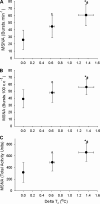Sympathetic nerve activity and whole body heat stress in humans
- PMID: 21868685
- PMCID: PMC3220304
- DOI: 10.1152/japplphysiol.00498.2011
Sympathetic nerve activity and whole body heat stress in humans
Abstract
We and others have shown that moderate passive whole body heating (i.e., increased internal temperature ∼0.7°C) increases muscle (MSNA) and skin sympathetic nerve activity (SSNA). It is unknown, however, if MSNA and/or SSNA continue to increase with more severe passive whole body heating or whether these responses plateau following moderate heating. The aim of this investigation was to test the hypothesis that MSNA and SSNA continue to increase from a moderate to a more severe heat stress. Thirteen subjects, dressed in a water-perfused suit, underwent at least one passive heat stress that increased internal temperature ∼1.3°C, while either MSNA (n = 8) or SSNA (n = 8) was continuously recorded. Heat stress significantly increased mean skin temperature (Δ∼5°C, P < 0.001), internal temperature (Δ∼1.3°C, P < 0.001), mean body temperature (Δ∼2.0°C, P < 0.001), heart rate (Δ∼40 beats/min, P < 0.001), and cutaneous vascular conductance [Δ∼1.1 arbitrary units (AU)/mmHg, P < 0.001]. Mean arterial blood pressure was well maintained (P = 0.52). Relative to baseline, MSNA increased midway through heat stress (Δ core temperature 0.63 ± 0.01°C) when expressed as burst frequency (26 ± 14 to 45 ± 16 bursts/min, P = 0.001), burst incidence (39 ± 13 to 48 ± 14 bursts/100 cardiac cyles, P = 0.03), or total activity (317 ± 170 to 489 ± 150 units/min, P = 0.02) and continued to increase until the end of heat stress (burst frequency: 61 ± 15 bursts/min, P = 0.01; burst incidence: 56 ± 11 bursts/100 cardiac cyles, P = 0.04; total activity: 648 ± 158 units/min, P = 0.01) relative to the mid-heating stage. Similarly, SSNA (total activity) increased midway through the heat stress (normothermia; 1,486 ± 472 to mid heat stress 6,467 ± 5,256 units/min, P = 0.03) and continued to increase until the end of heat stress (11,217 ± 6,684 units/min, P = 0.002 vs. mid-heat stress). These results indicate that both MSNA and SSNA continue to increase as internal temperature is elevated above previously reported values.
Figures


Similar articles
-
Cardiopulmonary baroreceptor control of muscle sympathetic nerve activity in heat-stressed humans.Am J Physiol. 1999 Dec;277(6 Pt 2):H2348-52. doi: 10.1152/ajpheart.1999.277.6.h2348. Am J Physiol. 1999. PMID: 10600855
-
Sympathetic activity during passive heat stress in healthy aged humans.J Physiol. 2015 May 1;593(9):2225-35. doi: 10.1113/JP270162. Epub 2015 Mar 25. J Physiol. 2015. PMID: 25752842 Free PMC article.
-
Whole body heat stress attenuates the pressure response to muscle metaboreceptor stimulation in humans.J Appl Physiol (1985). 2016 Nov 1;121(5):1178-1186. doi: 10.1152/japplphysiol.00212.2016. Epub 2016 Oct 7. J Appl Physiol (1985). 2016. PMID: 27763873 Free PMC article.
-
Sympathetic microneurography.Handb Clin Neurol. 2013;117:353-64. doi: 10.1016/B978-0-444-53491-0.00028-6. Handb Clin Neurol. 2013. PMID: 24095138 Review.
-
Autonomic responses to environmental stimuli in human body.Nagoya J Med Sci. 1994 May;57 Suppl:59-75. Nagoya J Med Sci. 1994. PMID: 7708112 Review.
Cited by
-
Longitudinal genomic analyses of automatically-recorded vaginal temperature in lactating sows under heat stress conditions based on random regression models.Genet Sel Evol. 2023 Dec 21;55(1):95. doi: 10.1186/s12711-023-00868-1. Genet Sel Evol. 2023. PMID: 38129768 Free PMC article.
-
Effects of Acute Exposure to Thermal Stress on Cardiorespiratory Function, Skeletal Muscle Oxygenation, and Exercise Performance in Healthy Males.Int J Environ Res Public Health. 2021 Jul 11;18(14):7404. doi: 10.3390/ijerph18147404. Int J Environ Res Public Health. 2021. PMID: 34299853 Free PMC article.
-
Muscle sympathetic nerve activity response to heat stress is attenuated in chronic heart failure patients.Am J Physiol Regul Integr Comp Physiol. 2017 Jun 1;312(6):R873-R882. doi: 10.1152/ajpregu.00355.2016. Epub 2017 Mar 22. Am J Physiol Regul Integr Comp Physiol. 2017. PMID: 28330967 Free PMC article.
-
Plasma epinephrine and norepinephrine responses to extreme heat exposures in young and older adults.Am J Physiol Regul Integr Comp Physiol. 2024 Aug 1;327(2):R188-R194. doi: 10.1152/ajpregu.00111.2024. Epub 2024 Jun 17. Am J Physiol Regul Integr Comp Physiol. 2024. PMID: 38881413 Free PMC article.
-
Impaired sweating responses to a passive whole body heat stress in individuals with multiple sclerosis.J Neurophysiol. 2017 Jul 1;118(1):7-14. doi: 10.1152/jn.00897.2016. Epub 2017 Mar 8. J Neurophysiol. 2017. PMID: 28275061 Free PMC article.
References
-
- Chen F, Liu F, Badoer E. AT1 receptors in the paraventricular nucleus mediate the hyperthermia-induced reflex reduction of renal blood flow in rats. Am J Physiol Regul Integr Comp Physiol 300: R479–R485, 2011 - PubMed
-
- Crandall CG, Cui J, Wilson TE. Effects of heat stress on baroreflex function in humans. Acta Physiol Scand 177: 321–328, 2003 - PubMed
-
- Crandall CG, Etzel RA, Farr DB. Cardiopulmonary baroreceptor control of muscle sympathetic nerve activity in heat-stressed humans. Am J Physiol Heart Circ Physiol 277: H2348–H2352, 1999 - PubMed
-
- Crandall CG, Levine BD, Etzel RA. Effect of increasing central venous pressure during passive heating on skin blood flow. J Appl Physiol 86: 605–610, 1999 - PubMed
Publication types
MeSH terms
Grants and funding
LinkOut - more resources
Full Text Sources
Other Literature Sources

